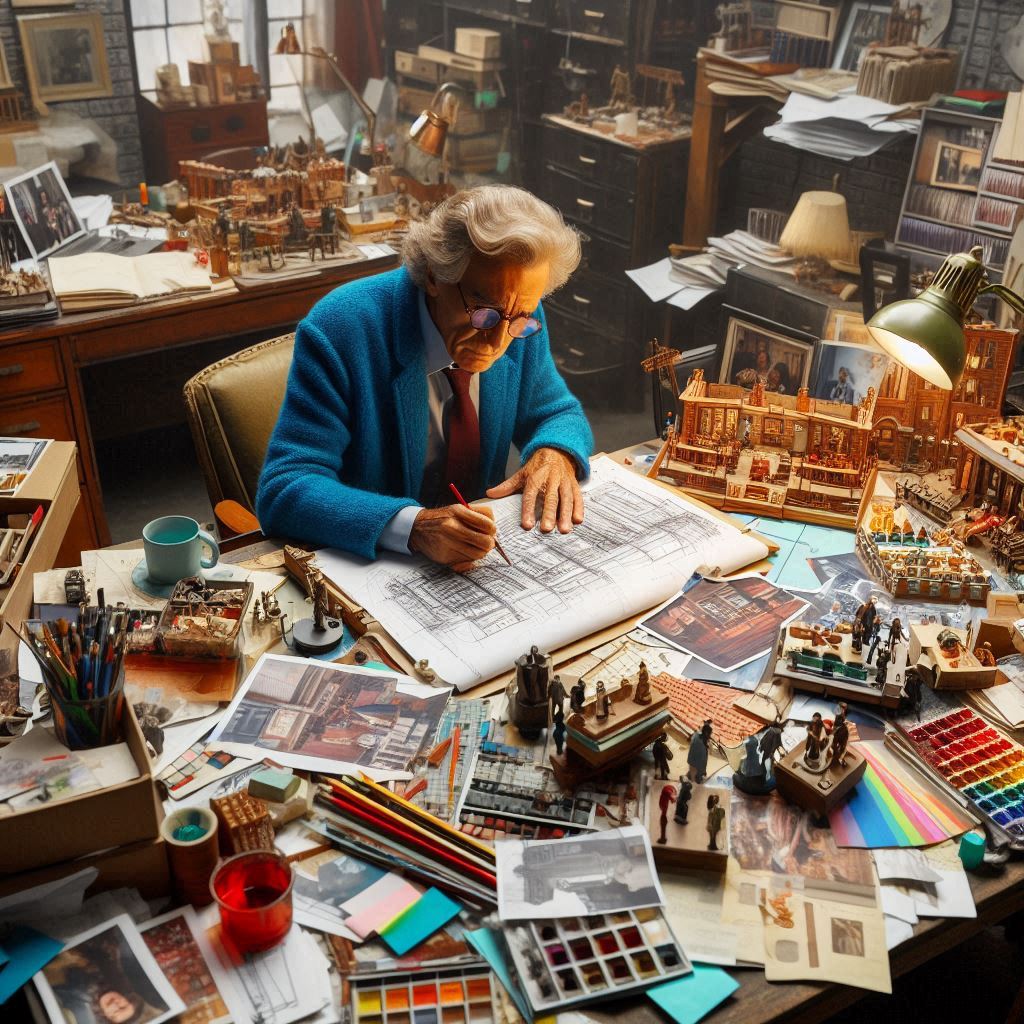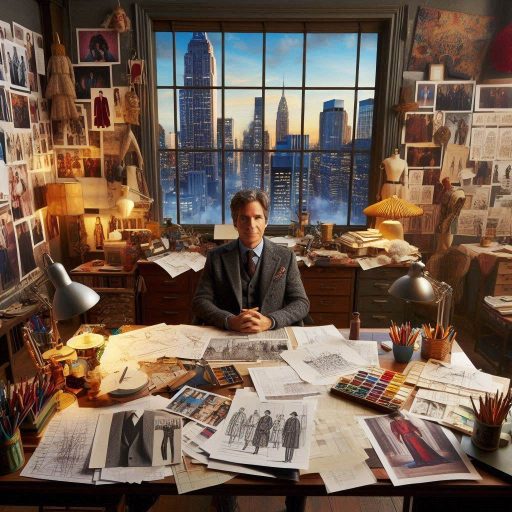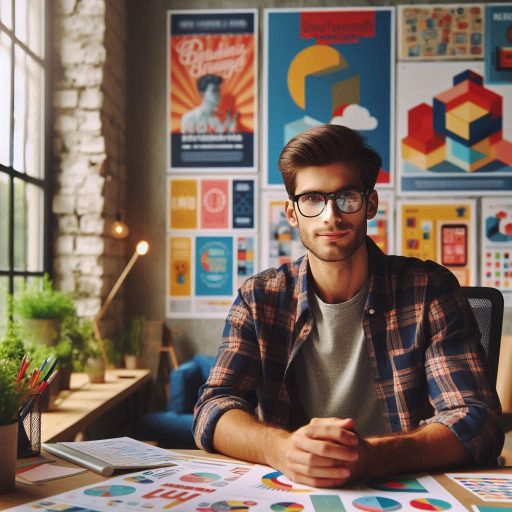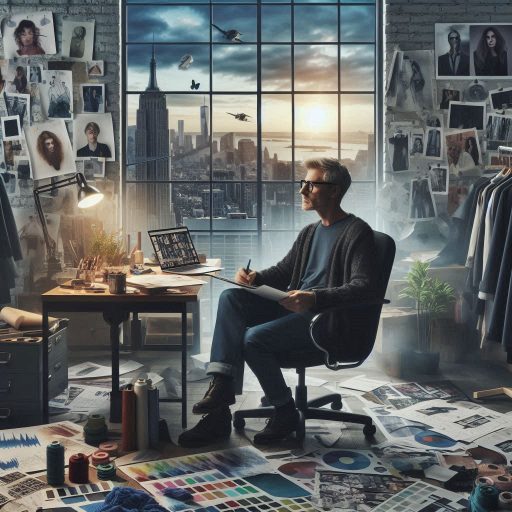Introduction
Production design involves creating the visual environment for film and television.
It plays a crucial role in building immersive sets that transport audiences into the story.
By crafting realistic and imaginative spaces, production design enhances the overall viewing experience and emotional impact.
Production designers are responsible for the overall look and feel of a production.
They interpret the script and collaborate with directors to create a cohesive visual style.
Their work includes conceptualizing sets, selecting color palettes, and overseeing construction processes.
Set decorators play a vital role in adding the final touches to these environments.
They source and arrange furniture, props, and accessories to create authentic settings.
Their attention to detail ensures that each element aligns with the story’s theme and period.
Art directors support production designers by managing the design team and overseeing the execution of visual concepts.
They help maintain consistency and quality throughout the production process.
Together, these roles work harmoniously to bring scripts to life through visual storytelling.
By combining creativity and technical skills, production teams create captivating worlds that resonate with audiences.
Ultimately, effective production design enhances narratives and enriches the viewer’s experience, making it an essential aspect of film and television.
Understanding Production Design
Production Design and Its Purpose in Creating the Overall Look and Feel of a Film or TV Show
Production design is the art of creating visual environments for films and television shows.
It encompasses all visual elements, including sets, props, and costumes.
The primary purpose of production design is to support the storytelling by establishing the overall look and feel of a project.
A well-executed production design enhances the narrative, drawing audiences into the world of the film or show.
It sets the mood and tone, helping to convey themes and emotions.
For example, a gritty urban environment can evoke feelings of tension, while a lush, vibrant landscape can create a sense of wonder.
Production designers begin their work by analyzing the script.
They consider the story, characters, and settings to create a cohesive visual language.
Collaborating closely with the director, they develop concepts that align with the director’s vision.
Once concepts are approved, production designers oversee the creation of sets and environments.
They manage a team of artists and craftsmen to bring ideas to life.
This collaboration ensures that every element of the design serves the overall narrative.
To create immersive sets, production designers often conduct extensive research.
They study historical references, architectural styles, and cultural elements relevant to the story.
This attention to detail enriches the visual experience, making the world feel authentic and believable.
The Difference Between Production Design and Set Decoration, Emphasizing the Collaborative Nature of Both Roles in Building Immersive Sets
While production design and set decoration are closely related, they serve different purposes.
Production design encompasses the overall visual concept and layout of the sets.
It includes the design of architectural elements, props, and the overall aesthetic.
On the other hand, set decoration focuses specifically on the furnishing and detailing of the sets.
Set decorators select and arrange furniture, artwork, and other decorative elements that enhance the environment.
Their goal is to create a lived-in feel that adds depth to the story.
Despite their distinct roles, production designers and set decorators work closely together.
They collaborate throughout the design process to ensure a cohesive visual experience.
Communication is vital in aligning their visions and maintaining consistency in the sets.
For example, a production designer might create the overall layout and visual concept for a living room set.
The set decorator then selects furniture and accessories that reflect the characters’ personalities and lifestyles.
This collaboration results in an immersive environment that feels authentic and believable.
Both roles require a keen eye for detail and a strong understanding of visual storytelling.
Successful production designers and set decorators possess excellent communication skills, allowing them to articulate their ideas effectively.
They also share a passion for creativity and a dedication to their craft.
Production design plays a crucial role in shaping the overall look and feel of films and television shows.
It creates immersive environments that enhance storytelling and engage audiences.
Understanding the difference between production design and set decoration highlights the collaborative nature of building these sets.
By working together, production designers and set decorators create visually stunning worlds that resonate with viewers, enriching their overall experience.
Read: Character Design Trends: What‘s Hot in 2024?
Researching and Conceptualizing
The Process of Researching and Conceptualizing Ideas for Sets
Creating immersive sets begins with thorough research and conceptualization.
Production designers delve into the script to understand the story‘s context and requirements.
They analyze character backgrounds, themes, and settings to inform their designs.
This deep understanding allows designers to create environments that enhance the narrative.
Gathering inspiration from various sources is essential during this phase.
Designers often explore historical photographs to capture authentic details and aesthetics.
These images provide insight into different eras, styles, and cultural elements.
Additionally, studying art movements can spark creative ideas and inform visual language.
Architecture plays a significant role in set design.
Designers examine different architectural styles to identify features that resonate with the story.
For instance, a Gothic-inspired set may evoke feelings of mystery and tension.
Conversely, a minimalist design can convey simplicity and modernity.
By understanding architectural principles, designers create more convincing and immersive environments.
Artistic inspiration also comes from paintings, sculptures, and other visual mediums.
Designers may analyze color palettes, textures, and compositions to incorporate into their sets.
This exploration can lead to unique interpretations and innovative design solutions.
Collaborating with art historians or visiting galleries can further enrich this creative process.
Additionally, traveling to relevant locations can provide invaluable insights.
Experiencing spaces firsthand helps designers grasp the ambiance and scale of real environments.
These experiences often lead to fresh ideas that elevate the overall design.
Once they gather inspiration, designers begin sketching their concepts.
These initial sketches allow for experimentation with layouts and ideas.
By creating multiple iterations, designers refine their vision and approach.
This process often involves collaboration with other departments, such as the art director and set decorators.
The Importance of Understanding the Script and Director’s Vision
Understanding the script is paramount in the production design process.
Designers must translate the narrative into a tangible, physical environment.
This translation requires them to identify key moments in the script that require specific set elements.
Collaboration with the director is essential for achieving the desired vision.
Designers should engage in discussions to grasp the director‘s interpretation of the story.
This communication ensures that the design aligns with the overall artistic direction of the project.
Directors often have specific ideas about the mood, tone, and atmosphere they want to create.
Designers need to listen carefully and ask questions to clarify these visions.
By establishing a strong collaborative relationship, designers can ensure that their designs meet the director’s expectations.
Furthermore, understanding character motivations and arcs informs the design choices.
Each character‘s environment should reflect their personality, status, and journey.
For example, a character‘s lavish mansion may signify wealth and power, while a cramped apartment may suggest struggle.
By incorporating these nuances, designers create more engaging and relatable environments.
Designers must also consider practical elements, such as budget and timeline constraints.
They should balance creative vision with logistical realities.
Collaborating with the production team ensures that designs can be realized within the available resources.
The process of building immersive sets involves thorough research and conceptualization.
Gathering inspiration from historical photographs, art, and architecture enriches the design process.
Understanding the script and the director’s vision is crucial for translating ideas into physical environments.
By effectively combining these elements, production designers create compelling and immersive sets that enhance the storytelling experience.
Read: How to Price Your Ceramic Artwork
Budgeting and Location Scouting
The Role of Budgeting in Production Design
Budgeting plays a crucial role in production design.
It directly influences the design and construction of sets.
Production designers must work within financial constraints while delivering compelling visuals.
The budget determines the materials, labor, and resources available for the project.
A limited budget may restrict the scope of the design.
Designers must prioritize their choices and focus on key elements that enhance the story.
Effective budgeting requires careful planning and forecasting.
Production designers collaborate with producers to create a detailed budget breakdown.
This collaboration ensures that everyone understands financial limitations from the beginning.
Designers must also allocate funds for unexpected expenses.
Contingency funds allow for flexibility if issues arise during production.
This foresight helps maintain the integrity of the design without compromising quality.
In many cases, production designers find creative solutions to stay within budget.
They may use recycled materials or repurpose existing sets.
Such strategies can significantly reduce costs while maintaining visual impact.
Budgeting also affects the timeline for set construction.
Tight budgets often lead to shortened production schedules.
Designers must balance efficiency with creativity to meet deadlines while delivering high-quality work.
The Process of Location Scouting
Location scouting is an essential part of building immersive sets.
It involves searching for the perfect backdrop to enhance the story.
Scouting locations helps designers envision how the environment complements the narrative.
Production designers work closely with location scouts to identify suitable sites.
They assess potential locations based on aesthetics, logistics, and suitability for the script.
Factors like lighting, access, and surrounding scenery are crucial during the evaluation process.
The chosen locations can greatly influence set design decisions.
For example, a historical site may dictate specific architectural styles and materials.
This context helps designers create a cohesive visual narrative that supports the storyline.
During location scouting, designers consider how spaces will be used on screen.
They visualize camera angles, blocking, and action sequences in the chosen settings.
This foresight ensures that the design enhances character interactions and story development.
Location scouting also contributes to the authenticity of the production.
Filming in real environments often adds depth and realism.
Audiences can connect with authentic settings, making the story more relatable and engaging.
Once locations are identified, production designers may conduct further research.
They gather reference images and materials that inform their designs.
This research enriches the visual language of the production.
Additionally, location scouting allows for collaboration with other departments.
Art directors, cinematographers, and producers discuss how locations impact overall production.
These conversations ensure a unified vision and coherent design across all aspects of the project.
In some cases, designers may combine practical locations with constructed sets.
This hybrid approach allows for creative flexibility while maintaining realism.
It also enables designers to craft immersive environments that reflect the story’s emotional landscape.
Read: Top Skills Needed for a Successful Character Designer

Set Construction and Decoration
Steps Involved in Constructing Sets
Constructing sets for film and television involves a systematic and collaborative process.
First, production designers create detailed blueprints that outline the set‘s layout.
These blueprints include measurements, dimensions, and specific design elements.
After finalizing the blueprints, the production team reviews them for approval.
This step ensures that the design aligns with the director‘s vision.
Once approved, the team gathers materials needed for construction.
They consider both budget constraints and the overall aesthetic of the set.
Next, skilled carpenters and craftsmen begin building the set.
They follow the blueprints closely to ensure accuracy and precision.
This construction phase typically involves framing, drywall installation, and structural support.
Attention to detail is crucial during this process to ensure a safe and visually appealing environment.
Once the basic structure is complete, the team adds architectural elements.
This may include windows, doors, and other significant features.
Production designers often incorporate practical elements that enhance the set‘s functionality.
Afterward, the painting and finishing touches begin.
Set painters apply colors and textures to achieve the desired look.
They may also weather the surfaces to create a sense of age and realism.
Finally, the construction team performs a thorough inspection of the set.
They check for safety, stability, and aesthetic quality before moving on to the next phase.
This careful preparation ensures that the set is ready for filming.
The Role of Set Decorators in Enhancing Authenticity
Set decorators play a vital role in bringing sets to life.
Once the physical structures are complete, they step in to add details that enhance authenticity.
Their work involves selecting and arranging furniture, props, and decorative elements.
Set decorators collaborate closely with production designers to align with the overall vision.
They understand how specific items contribute to the storytelling and character development.
Each prop or piece of furniture must reflect the time period and setting accurately.
The process begins with sourcing items for the set.
Set decorators often search for unique and appropriate pieces that fit the narrative.
This may involve visiting antique shops, flea markets, or rental houses for one-of-a-kind items.
Once they gather the necessary props, set decorators begin the placement process.
They consider the composition of each scene when arranging items.
A well-decorated set creates visual interest and supports the story being told.
Lighting also plays a crucial role in the set’s authenticity.
Set decorators often work alongside the lighting team to ensure that the items are displayed effectively.
The interplay of light and shadow enhances the overall atmosphere of the set.
Additionally, set decorators pay attention to small details that add depth.
This can include books on a shelf, plants in a corner, or personal items in a character‘s space.
These elements make the set feel lived-in and believable.
Collaboration with actors is also essential.
Set decorators may discuss with performers how they interact with the space.
Understanding this interaction helps them fine-tune details and placement.
Constructing immersive sets involves a detailed process from blueprints to physical builds.
Each step requires careful planning and execution.
Set decorators then enhance these spaces by adding details and props that create authenticity.
Together, these efforts result in captivating environments that transport audiences into the world of the story.
Read: Career Paths in Ceramic Art and Design
Collaboration with Other Departments
The Intersection of Production Design and Costume Design
Costume design and production design work hand in hand to establish a film’s visual identity.
Costume designers create clothing that reflects characters’ personalities and backgrounds.
Production designers ensure that the sets complement these choices, enhancing the overall look.
In the film “The Great Gatsby,” production designer Catherine Martin collaborated closely with costume designer Miuccia Prada.
They created a stunning visual landscape that reflects the opulence of the Roaring Twenties.
The vibrant costumes and lavish sets immerse viewers in the era’s glamour.
Similarly, in “Dunkirk,” production designer Nathan Crowley worked with costume designers to capture the historical authenticity of World War II.
The seamless integration of costumes and sets transports viewers to the battlefield.
This collaboration allows the audience to experience the time period fully.
Enhancing Atmosphere with Lighting
Lighting is another critical element that intersects with production design.
It can drastically change the mood and perception of a set.
Production designers must collaborate with lighting designers to ensure their vision aligns.
In “Blade Runner 2049,” production designer Dennis Gassner and cinematographer Roger Deakins worked together to create a striking visual aesthetic.
Their collaboration produced a futuristic world filled with rich colors and contrasting shadows.
The lighting enhances the emotional impact of the scenes and complements the set design.
In the series “Game of Thrones,” the collaboration between production designers and lighting teams brought the fictional world of Westeros to life.
They used dramatic lighting to emphasize the vast landscapes and intricate sets.
This synergy created an immersive experience for viewers.
Cinematography and Production Design Collaboration
Cinematography also plays a crucial role in production design.
Cinematographers translate the production designer’s vision into moving images.
Their collaboration ensures that the set’s aesthetic translates effectively on screen.
In “Inception,” production designer Guy Hendrix Dyas worked closely with cinematographer Wally Pfister.
Their partnership resulted in a mind-bending visual experience.
The iconic rotating hallway scene demonstrates how production design and cinematography can create stunning visuals that enhance storytelling.
Another example is “The Grand Budapest Hotel.
” Production designer Adam Stockhausen and cinematographer Robert Yeoman crafted a unique visual style.
Their collaboration produced symmetrical compositions and vibrant colors.
This attention to detail creates a whimsical yet immersive environment.
Successful collaborations between production designers and other departments are essential for building immersive sets.
The synergy between costume design, lighting, and cinematography enhances the audience’s experience.
When these elements work together, they create a cohesive world that draws viewers in.
The collaborative nature of production design is vital for crafting immersive environments.
By working closely with costume designers, lighting teams, and cinematographers, production designers can create visually stunning and emotionally resonant worlds.
These collaborations enrich storytelling and elevate the overall cinematic experience for audiences.
Uncover the Details: Networking Tips for Lighting Design Professionals
Using Technology in Production Design
Technology‘s Role in Enhancing Production Design
Technology plays a pivotal role in modern production design, enhancing the creative process.
Tools like computer-generated imagery (CGI) and virtual reality (VR) have revolutionized how designers create sets.
These advancements enable designers to visualize concepts before physical construction begins, streamlining the creative process.
CGI allows designers to create stunning visual elements that may be impossible to achieve practically.
It enables the integration of fantastical landscapes and intricate details into the set design.
With CGI, designers can explore limitless possibilities, crafting environments that captivate audiences and immerse them in the story.
Moreover, CGI offers flexibility during the design process.
Designers can easily modify digital elements, making it simple to experiment with colors, textures, and layouts.
This adaptability saves time and resources, allowing designers to focus on refining their artistic vision.
It also reduces the risk of costly mistakes during physical construction.
Virtual Reality: Immersive Design Experiences
Virtual reality technology has also transformed production design.
VR allows designers and directors to explore sets in a fully immersive environment.
By wearing VR headsets, they can experience the space as if they were physically present.
This immersion provides valuable insights into scale, lighting, and spatial relationships.
Designers can use VR to simulate how elements interact within a set.
This capability allows them to identify potential issues early in the process.
They can adjust designs based on real-time feedback, ensuring a seamless production experience.
This immediate interaction helps create more cohesive and effective designs.
Furthermore, VR technology enhances collaboration among team members.
Designers, directors, and cinematographers can share the same virtual space.
This shared experience fosters open communication and collaboration, leading to more innovative ideas.
It streamlines decision-making, as everyone can visualize the same set in real time.
Advancements Revolutionizing Set Design
Recent advancements in technology have drastically changed how sets are designed and brought to life.
High-definition projection and LED screens have become common in modern productions.
These technologies allow designers to create dynamic backgrounds that can shift and change throughout a scene.
Using these tools, designers can craft environments that feel alive and reactive.
They can blend practical elements with digital enhancements seamlessly.
This combination results in sets that are not only visually stunning but also immersive for the audience.
Moreover, advancements in 3D printing have made it easier to create intricate set pieces.
Designers can quickly produce unique props and set elements that add authenticity.
This capability opens up new avenues for creativity and experimentation, as designers can bring their visions to life in tangible ways.
The integration of sustainable materials and practices has also emerged due to technological advancements.
Designers can now source eco-friendly materials and use energy-efficient processes.
This focus on sustainability aligns with the industry’s growing awareness of environmental impact.
It allows designers to create beautiful sets while minimizing their carbon footprint.
The role of technology in production design is undeniable.
Tools like CGI and virtual reality enhance the creative process, allowing designers to build immersive sets.
These advancements have revolutionized how sets are conceived, designed, and realized on screen.
As technology continues to evolve, production design will likely become even more innovative and exciting, captivating audiences and enhancing storytelling.
Embracing these changes will help designers push boundaries and create unforgettable visual experiences.
Transform Your Career Today
Unlock a personalized career strategy that drives real results. Get tailored advice and a roadmap designed just for you.
Start NowConclusion
Production design plays a crucial role in building immersive sets that captivate audiences.
It involves creating environments that enhance storytelling and engage viewers.
A well-designed set transports the audience into the world of the narrative.
Key elements of production design include color, texture, and spatial arrangement.
Each component contributes to the overall atmosphere and emotional impact of a scene.
Designers collaborate closely with directors and cinematographers to ensure a cohesive vision.
Artistry and creativity are at the heart of production design.
Designers often draw inspiration from various sources, such as art history, architecture, and nature.
This diverse influence allows them to craft unique, visually striking environments.
Attention to detail is essential in creating believable sets.
From props to lighting, every element must serve a purpose and align with the story.
The immersive experience relies on the seamless integration of all components.
As viewers, we should appreciate the hard work and creativity that go into production design.
Each set is a labor of love, reflecting the designer‘s vision and dedication.
Recognizing the artistry involved enhances our understanding of film and television.
The next time you watch a show or movie, take a moment to admire the immersive sets that bring stories to life.
[E-Books for Sale]
The Big Book of 500 High-Paying Jobs in America: Unlock Your Earning Potential
$19.99 • 500 High-Paying Jobs • 330 pages
Explore 500 high-paying jobs in America and learn how to boost your career, earn more, and achieve success!
See All 500 High-Paying Jobs of this E-Book
1001 Professions Without a Degree: High-Paying American Jobs You Can Start Now
$19.99 • 1001 Professions Without a Degree • 174 pages
Discover 1001 high-paying jobs without a degree! Unlock career tips, skills, and success strategies for just $19.99!




